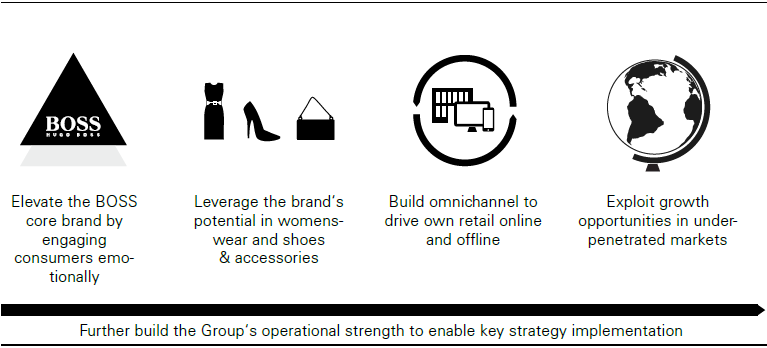Group strategy

HUGO BOSS has set itself the goal of growing strongly and improving its profitability. The basis for this is the Group’s core competence – the development and marketing of high-quality apparel as well as shoes and accessories in the premium and luxury segment. Thanks to its industrial scale and strength, HUGO BOSS offers its customers an attractive range of products characterized by consistently advantageous value for money compared with the competition. In 2014, the Group enhanced its proven strategy, defining new focal points. The Group’s strategy aims at elevating the core BOSS brand, expanding its market position in womenswear, developing the Group’s own retail business, achieving global growth and maximizing operational strength.
HUGO BOSS aiming for continued profitable growth
The Group’s successful business performance over the past few years underscores the strength of HUGO BOSS’ business model. On this basis, the Group is striving for average sales growth in the high single digits until 2020. The operating margin is to be increased to 25% over the same period. The planned increase in earnings, together with the strict management of trade net working capital as well as disciplined capital spending, will form the basis for the planned maximization of free cash flow. In this way, the Group’s enterprise value will continue to grow. In addition, shareholders participate in the Group’s success via the earnings-oriented dividend policy. Group Management
Growth strategy based on five pillars
HUGO BOSS has identified five levers for ensuring profitable growth. The BOSS core brand is to be enhanced by means of product, distribution and communication measures. The brand strength, which has its roots in menswear, is to be leveraged to a greater extent than before in womenswear, including shoes and accessories. The expansion of omnichannel offerings will spur continued growth in the Group’s own retail business in both the online and offline segment. Finally, the Group is seeking a stronger regional balance than before and plans to generate a greater volume of sales outside its European home market in the medium term. Building on the Group’s operational strengths, particularly supply chain management, the product development process and the IT and logistics infrastructure, will provide substantial support to the implementation of the various growth initiatives.
HUGO BOSS growth strategy 2020
